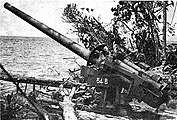14 cm/50 3rd Year Type naval gun
The 14 cm/50 3rd Year Type naval gun was a Japanese low-angle weapon introduced during World War I.
| 14 cm/50 3rd Year Type naval gun | |
|---|---|
 14 cm/50 3rd Year Type naval gun from the battleship Mutsu | |
| Type | Naval gun Coast-defense gun |
| Place of origin | Japan |
| Service history | |
| In service | 1914–1945 |
| Used by | |
| Wars | |
| Specifications | |
| Mass | 5,600–5,700 kilograms (12,346–12,566 lb) |
| Barrel length | 7.0 meters (23 ft 0 in) (bore length) |
| Shell | separate-loading, bagged charge |
| Shell weight | 38 kilograms (84 lb) |
| Caliber | 14 centimeters (5.5 in) |
| Breech | Welin breech block |
| Elevation | -7° to +35° depending on mount[1] |
| Rate of fire | About 6 rounds per minute |
| Muzzle velocity | 850–855 meters per second (2,790–2,810 ft/s) |
| Maximum firing range | 19,750 meters (21,600 yd) at +35°[1] |
History
It served as the secondary armament in a number of Japanese dreadnoughts and as the main armament in light cruisers and some auxiliary ships. It was also the most common Japanese coast-defense gun during World War II. "Third year type" refers to the Welin breech block on this gun. Breech-block design began in 1914, the third year of the Taishō period. This breech-block design was also used on Japanese 40 cm (16 inch), 20 cm (8 inch), 15.5 cm (6 inch), 12.7 cm (5 inch), and 12 cm (4.7 inch) naval guns.[2]
This gun was not mounted aboard submarines. Submarine cruisers used the shorter-barreled 14 cm/40 11th Year Type naval gun.[3]
Naval Use
- Akagi Maru-class armed merchantmen
- Ise-class battleship
- Jingei-class submarine tender
- Katori-class cruiser
- Kongō Maru-class armed merchantmen
- Kuma-class cruiser
- Nagara-class cruiser
- Nagato-class battleship
- Ning Hai-class cruiser
- Sendai-class cruiser
- Tenryū-class cruiser
See also
Weapons of comparable role, performance and era
- BL 5.5 inch Mark I naval gun : British equivalent
- Canon de 138 mm Modèle 1910 Naval gun : French equivalent
Gallery
 A 3rd Year Type gun used for coastal defense.
A 3rd Year Type gun used for coastal defense. A captured gun after the Battle of Enogai.
A captured gun after the Battle of Enogai.- A turret mounted gun captured on Tarawa.
 One of the three surviving Piti Guns on Guam.
One of the three surviving Piti Guns on Guam.
Notes
- Campbell, p. 190
- Campbell, pp. 173, 190
- Campbell, pp. 190–91
References
- Campbell, John (1985). Naval Weapons of World War II. Annapolis, MD: Naval Institute Press. ISBN 0-87021-459-4.
External links
| Wikimedia Commons has media related to 14 cm/50 3rd Year Type naval gun. |
This article is issued from Wikipedia. The text is licensed under Creative Commons - Attribution - Sharealike. Additional terms may apply for the media files.